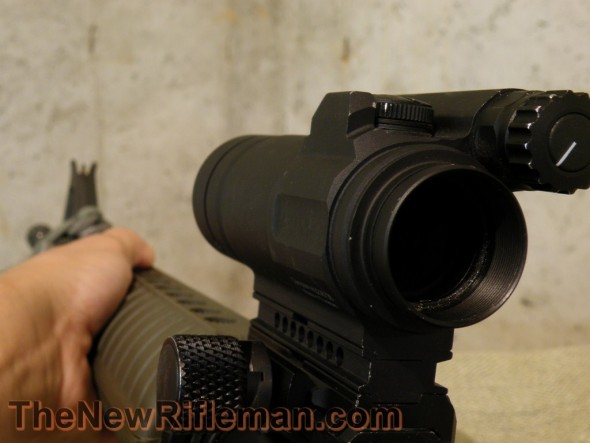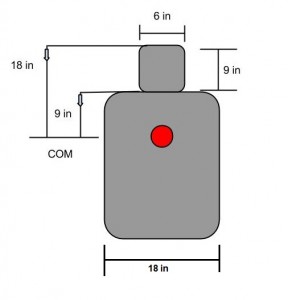A rifleman is a well-balanced marksman. What makes us versatile shooters is the ability to develop a system that allows us to estimate a target’s range, the target’s condition, and to execute a well-aimed shot on the fly. Some people use the irons for this very effectively. Some people spring for optics such as the ACOG with bullet drop compensation. Many of us though, have red dot sights. I think we often put red dots in a box… but the reality is that they can be used effectively for simple distance shooting. I put together a chart to look at two common calibers and explore the dot size in relation to bullet drop with a 200 yard zero.
A Quick and Dirty MOA Explanation for Those Unfamiliar:
1 MOA is roughly equal to 1 inch at 100 yards. For anyone who is unfamiliar with using MOA here is a very basic explanation. Let’s use a 7 MOA red dot sight in this example. At 100 yards the dot would cover 7 inches. At 200 yards the dot would cover 14 inches. At 300 the dot would cover 21 inches. The average shoulder width of an adult male is 18.5 inches. So if you were looking at a target 300 yards out with a 7MOA dot… the body of the target would be completely covered by the red dot. In this example 7 MOA really limits the ability to hit a target at 300 yards. It’s simply too big a dot.
Below is a graphic that shows average sizes that we use when we estimate the range. Shoulder to shoulder is 18 inches. Chin to center of mass is 9 inches. Top of head to COM is 18 inches. Etc.
 The Chart:
The Chart:
Some information before we begin. This chart represents different dot sizes and two different calibers are listed. The zero for each projectile is a 200 yard zero. The readings below the dot size represent how large the dot will appear at each range, in inches. So a 2 MOA dot at 300 yards will cover 6 inches. Knowing how to use the dot’s MOA we can make rough estimates based on shoulder width or head size relative to the dot size. For example if we are shooting 7.62×39 with a 7 MOA red dot and find that the target is completely covered shoulder width by the red dot… we can estimate the target is past 300 yards. Adjust your hold over accordingly.
Example 2: shooting 5.56 at a B27 silhouette with a 4 MOA red dot… and the targets head is covered up by the dot, and the dot only covers half the shoulder width, then we can estimate the target to be at roughly 200-250 meters. If the dot covers the body shoulder to shoulder we can estimate the target to be at 450 + yards.
Blue = where the dot starts to obscure the head
Red = where the dot is roughly shoulder width
Ammo: 123 gr 7.62×39 at 2355 FPS and 55 grain 5.56×45 at 3240 FPS
| Yards | 7.62×39 | 5.56×45 | 2 MOA | 3.5 MOA | 4 MOA | 7 MOA | 12.9 MOA Triangle |
| 100 | 3.3 | 0.9 | 2 | 3.5 | 4 | 7 | 12.9 |
| 150 | 2.9 | 1.1 | 3 | 5.25 | 6 | 10.5 | 19.35 |
| 200 | 0 | 0 | 4 | 7 | 8 | 14 | 25.8 |
| 250 | -5.7 | -2.4 | 5 | 8.75 | 10 | 17.5 | 32.25 |
| 300 | -14.9 | -6.4 | 6 | 10.5 | 12 | 21 | 38.7 |
| 350 | -28.2 | -12.3 | 7 | 12.25 | 14 | 24.5 | 45.15 |
| 400 | -46.3 | -20.4 | 8 | 14 | 16 | 28 | 51.6 |
| 450 | -70 | -30.9 | 9 | 15.75 | 18 | 31.5 | 58.05 |
| 500 | -100.1 | -44.3 | 10 | 17.5 | 20 | 35 | 64.5 |
The chart becomes more useful if we can use it to not only roughly estimate range, but to help us adjust for bullet drop. I range a target with a 4MOA dot to roughly 300 yards. The dot barely covers the face. With a 200 yard zero the 5.56 55 grain XM193 projectile will fall -6.4 inches below zero. If we use the dot hold over on the head of the B27 silhouette and have the bullet drop into the upper chest of the target. Keep in mind this is simply quick and dirty range estimation. In practice you will need to determine what works best for your setup… However, taking an educated shot will better aid us than guesstimation.
The 12.9 MOA triangle is something I don’t have personal experience with. The bottom edge would be used for range estimation, but due to the taper of the tip I think it might take some practice to learn it well.
Wrapping Up:
Getting into the ballpark range with the flatter shooting calibers would lead to hits on target. A red dot can be useful for simple ranging and we can then use the size of the dot to aid us with hold-over. Each setup and caliber will benefit from simply learning your drop and developing a system of hold-over specific to your setup. I like to use the head and the top of the head for hold overs with my 2 MOA dot. It is a very sharp dot so it fits inside a b27 all the way out to 500 yards ergo is not as useful for quick and dirty ranging. I will continue to experiment with dot sizes and different setups.










Nice analysis Lothaen. Thanks.
I have been playing around with my AR15 RDS too because I think it might be used as a range finder. But my idea is a good bit different from yours.
You see, I have an adjustable rear sight (KAC 200 – 600m micro) and a Vortex Sparc II in absolutely co-witness. When both are zeroed to the same range the dot appears centered with half of its width above and half of its width below the uppermost tip of the front sight post. Seems like that’s the way it should be in absolutely zero.
But, I noticed that when I crank the rear sight turret all the way to 600 m (raises the rear aperture about 1/4″) and then sight in on the front sight post using the rear sight aperture the red dot is well above the front sight post. And, the amount the dot climbs about the FSP depends on how many clicks I put in “up elevation” on the rear sight.
I think that with a little high school geometry this too could be used for modest range estimation. And, I’ve been working out the math.
But I’m perplexed about something. I can’t figure out why the red dot climbs about the FSP when the rear sight increases in height. Here’s why. Hold out your left hand and with all fingers folded but for the index and middle finger and keep them separated by an inch or two to simulate the FSP (middle finger) and red dot (index finger) and tilt your hand until their even at top in your line of sight. Then with your right hand form an aperture and hold it close to your eye and line up the center two fingers on your left hand (again at the same height) in the aperture (simulates the rear sight in this example). Then without moving the left hand raise the “aperture” slightly. You’ll see that the index finger which simulates the red dot falls away and doesn’t rise like the red dot does.
Hey, what’s up with that. Why does the dot rise in the sight picture instead of fall when the rear sight aperture rises?
If I can figure that out, I think I may have a way to use the clicks of the rear sight to estimate range.
LF
Well, I never did figure out why the dot climbs when you adjust the rear sight to longer ranges, but, that’s probably not important. It moves with each click, so, the two sights together can be used to estimate range.
For my rifle the rear elevation sight moves the POI 0.75″ per click at 100 yards (3/4 MOA). And, the sight has 30 clicks from it’s 200 yard zero. Furthermore, my Vortex Sparc II has a dot that is 2 MOA.
So, if we assume that, like Lothean, we put the 2 MOA dot on the head of the target individual and get an initial estimate of the range, we can leave the dot on the head of a 72″ inch tall individual and crank up the rear sight until we see the iron sights are sited on the feet and the dot is on the head. Then the following table applies:
Yards Inches / Click Clicks
100 0.75 80
125 0.94 64
150 1.13 53
175 1.31 46
200 1.50 40
225 1.69 36
250 1.88 32
275 2.06 29
300 2.25 27
325 2.44 25
350 2.63 23
375 2.81 21
400 3.00 20
425 3.19 19
450 3.38 18
475 3.56 17
500 3.75 16
525 3.94 15
550 4.13 15
575 4.31 14
600 4.50 13
Of course, we only have 30 clicks. So, according to the above table this method will only work for ranges from 275 yards to the maximum effective range of the AR-15 which I’ll take to be 600 yards. As the rifle is zeroed at 200 yards and as the maximum point blank range is around 275, that’s a perfect fit…I shoot point blank to 275 and then try to range beyond that.
Longfisher
Very helpful. I am looking to purchasing a red dot. I am trying to figure out which one to get a 2 MOA are a 4 MOA. sight. .